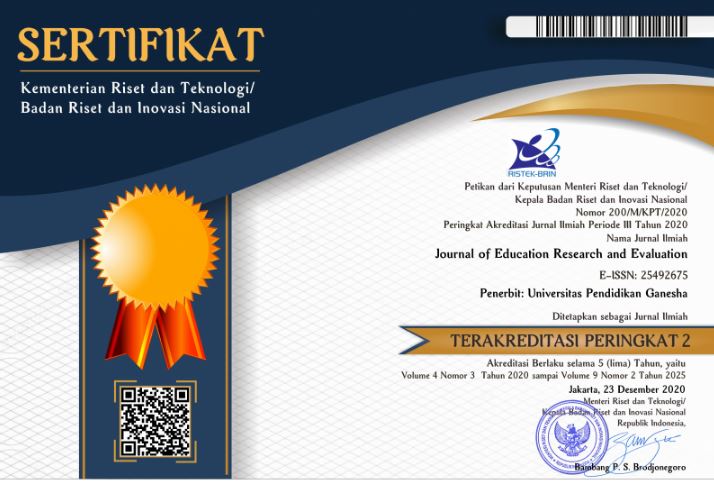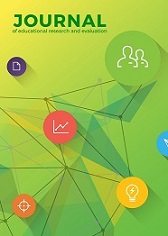The Effect of Scientific Approach Based on Portfolio Assessment towards the Learning Outcomes of Civic Education of the Students Grade V Viewed from the Tendency of Observing Objects on Theme 7 SDN 4 Ubung
DOI:
https://doi.org/10.23887/jere.v1i2.9842Keywords:
Scientific approach, Portfolio, Concrete objects, Abstract objects and learning outcomes of civicsAbstract
This study is aimed at determining significant differences between the Civics learning outcomes of the students who took a scientific approach based learning with portfolio assessment in terms of concrete objects and students who took a scientific approach based learning with portfolio assessment in terms of abstract objects. This study is a pre-experiment (pre-experimental design) with the design of the study was the Static Group Pretest-Posttest Design. The population in this study was the students of grade V SDN 4 Ubung Denpasar, in the academic year 2014/2015, amounting to 60 people. The samples were taken by using random sampling techniques. The data in the form of the value of Civics learning outcomes were collected with the usual multiple-choice test. The data were analyzed using descriptive statistics and t-test. The results showed that there were differences between the Civics learning outcomes of students who took a scientific approach based learning with portfolio assessment in terms of concrete objects and students who took a scientific approach based on learning through portfolio assessment in terms of abstract objects with t = 2.29, t table with 5% level of significance and db = 58, obtained t table at 2.00. This meant that tobserved > ttable (2.29> 2.00). Based on these results, it could be concluded that the scientific approach based on a portfolio assessment in terms of the object being observed on the theme of the history of civilization of Indonesia influenced the learning outcomes of Civics of the students grade V in SDN 4 Ubung Denpasar.
References
Agung, A.A.Gede. (2011). Prosedur Penelitian Suatu Pendekatan Praktek. Singaraja: Universitas Pendidikan Ganesha.
Anggoro, Toha. 2008. Metode Penelitian. Jakarta: Universitas Terbuka.
Dahar, Ratna. W. Teori-Teori Belajar dan Pembelajaran. 2011. Bandung Erlangga
Darmadi, Hamid. (2011). Metode Penelitian Pendidikan. Bandung: Alfabeta.
Daryanto. (2014). Pendekatan Pembelajaran Saintifik Kurikulum 2013. Yogyakarta: Gava Media.
Hamalik, Oemar. (2013). Kurikulum dan Pembelajaran. Jakarta: Bumi Aksara
Herron, J. Dudley., et. al. (1977). Journal of Science Education: Problems Associated With Concept Analysis. Dapat Dilihat Pada: http://onlinelibrary.wiley.com/doi/10 .1002/sce.3730610210/abstract (Diakses Pada Tanggal 19 Desember 2014)
Jihad, dkk. (2012). Evaluasi Pembelajaran.Yogyakarta : Multi Pressindo.
Kosasih. 2014. Strategi Belajar dan Pembelajaran Implementasi Kurikulum 2013. Bandung : Yrama Widya
Koyan. (2011). Asesmen dalam Pendidikan. Singaraja: Universitas Pendidikan Ganesha Press.
Kunandar. 2014. Penilaian Autentik(Penilaian Hasil Belajar Peserta Didik Berdasarkan Kurikulum 2013). Jakarta : Raja Grafindo Persada.
Kurniasih, Imas dan Sani, Berlin. 2014. Sukses mengimplementasikan kurikulum 2013. Kata Pena.
Marhaeni, A.A.I.N. (2013). Landasan dan Inovasi Pembelajaran. Singaraja:Program Pasca Sarjana Universitas Pendidikan Ganesha.
Mulyani Sumantri dkk.2004. Media Pembelajaran. Jakarta: Rineka Cipta.
Mutmainnah. (2012). Konsep Konkret: Teori Gagne. Dapat Dilihat Pada https://mutmainnahlatief.wordpress .com/tag/konsep-konkrit/ (Diakses Pada Tanggal 19 Desember 2014).
Permendiknas No.22 Tahun 2006 Tentang Standar Isi.
Peraturan Menteri Pendidikan dan Kebudayaan Republik Indonesia Nomor 81a Tahun 2013 Tentang Implementasi Kurikulum. Tersedia padahttp;//www.scribd.com/doc/237332 296/Salinan-Permen-No-81a- Tahun-2013#scribd(diakses pada tanggal 20Desember 2014).
Sudijono, Anas. (2009). Pengantar Evaluasi Pendidikan. Jakarta : PT Rajagrafindo Persada.
Sugiyono. (2013). Metode Penelitian Pendidikan. Bandung:Alfabeta.
Sukmadinata, Syaodiah. 2010. Metode Penelitian Pendidikan. Bandung: PT. Remaja Rosdakarya.
Susanto, Ahmad. 2013. Teori Belajar dan Pembelajaran di Sekolah Dasar. Jakarta: Prenada Media Group.
Thoifuri. (2007). Menjadi Guru Inisiator. Semarang: Rasail Media Group.
Trianto. (2010). Mendesain Model Pembelajaran Inovatif-Progresif Konsep, Landasan dan Implementasinya pada KTSP. Jakarta: Kencana Prenada Media Group.
Udjiku. (2012). Media Pengajaran Abstrak. Dapat Dilihat Pada: http://udjikku.blogspot.com/2012/0 1/media-pengajaran-abstrak.html (Diakses Pada Tanggal 19 Desember 2014)
Undang-Undang No. 20 Tahun 2003 Tentang Sistem Pendidikan Nasional.
Winarno. (2013). Pembelajaran Pendidikan Kewarganegaraan. Jakarta :PT. Bumi Aksara.
Winarsunu. 2009. Statistika dalam Penelitian Psikologi dan Pendidikan. Malang: Universitas Negeri Malang.
Yoyon Triyono. (2014). Media Benda Konkret dalam Pembelajaran. Dapat Dilihat Pada:http://triyonoyoyon.blogspot.c om/2014/06/media-benda-konkret-dalam-pembelajaran.html (Diakses Pada Tanggal 19 Desember 2014).
Yus, Anita. (2006). Penilaian Portofolio untuk Sekolah Dasar. Jakarta: Departemen Pendidikan Nasional.
Downloads
Published
How to Cite
Issue
Section
License
Authors who publish with the Journal of Evaluation and Research in Education (JERE) agree to the following terms:
- Authors retain copyright and grant the journal the right of first publication with the work simultaneously licensed under a Creative Commons Attribution License (CC BY-SA 4.0) that allows others to share the work with an acknowledgment of the work's authorship and initial publication in this journal.
- Authors are able to enter into separate, additional contractual arrangements for the non-exclusive distribution of the journal's published version of the work (e.g., post it to an institutional repository or publish it in a book), with an acknowledgment of its initial publication in this journal.
- Authors are permitted and encouraged to post their work online (e.g., in institutional repositories or on their website) prior to and during the submission process, as it can lead to productive exchanges, as well as earlier and greater citation of published work. (See The Effect of Open Access)










